Related Research Articles

Israeli settlements or colonies are civilian communities where Israeli citizens live, almost exclusively of Jewish identity or ethnicity, built on lands occupied by Israel since the Six-Day War in 1967. The international community considers Israeli settlements to be illegal under international law, though Israel disputes this.
Jewish fundamentalism refers to fundamentalism in the context of Judaism. The term fundamentalism was originally used in reference to Christian fundamentalism, a Protestant movement which emphasizes a belief in biblical literalism. Today, it is commonly used in reference to movements that oppose modernist, liberal, and ecumenical tendencies within society as well as modernist, liberal and ecumenical tendencies within specific religions and it is often coupled with extremist ideologies and/or political movements. The use of this definition is important in a Jewish context because the two movements which are most commonly associated with Jewish fundamentalism, Religious Zionism and Haredi Judaism, stray far from biblical literalism due to the importance of the Oral Law within Judaism. In fact, Karaism, the Jewish movement which is well-known due to its emphasis on biblical literalism, is rarely considered fundamentalist.
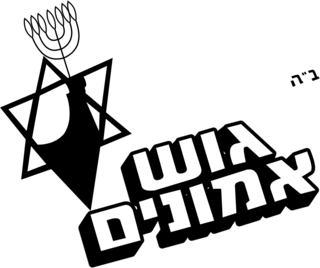
Gush Emunim was an Israeli ultranationalist Orthodox Jewish right-wing fundamentalist activist movement committed to establishing Jewish settlements in the West Bank, Gaza Strip, and Golan Heights.
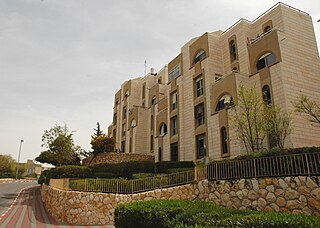
Ma'ale Adumim is an urban Israeli settlement organized as a city council in the West Bank, seven kilometers east of Jerusalem. Ma'ale Adumim achieved city status in 1991. In 2015, its population was 37,555. It is located along Highway 1, which connects it to Jerusalem and the Tel Aviv Metropolitan Area. The international community considers Israeli settlements in the West Bank illegal under international law, but the Israeli government disputes this.

Gush Etzion is a cluster of Israeli settlements located in the Judaean Mountains, directly south of Jerusalem and Bethlehem in the West Bank. The core group includes four Jewish agricultural villages that were founded in 1943–1947, and destroyed by the Arab Legion before the outbreak of the 1948 Arab–Israeli War, in the Kfar Etzion massacre. The area was left outside of Israel with the 1949 armistice lines. These settlements were rebuilt after the 1967 Six-Day War, along with new communities that have expanded the area of the Etzion Bloc. As of 2011, Gush Etzion consisted of 22 settlements with a population of 70,000.
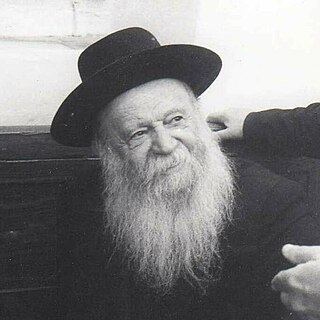
Zvi Yehuda Kook was an ultranationalist Orthodox rabbi. He was the son of Abraham Isaac Kook, the first Ashkenazi chief rabbi of British Mandatory Palestine. Both father and son are credited with developing Kookian Zionism, which became the dominant form of Religious Zionism. He was Rosh Yeshiva (dean) of the Mercaz HaRav yeshiva.

Beit El or Beth El is an Israeli settlement and local council located in the Binyamin Region of the West Bank. The Orthodox Jewish town was settled in 1977–78 by the ultranationalist group Gush Emunim. It is located in the hills north of Jerusalem, east of the Palestinian city of al-Bireh, adjacent to Ramallah. In September 1997, Beit El was awarded local council status. The head of the local council is Shai Alon. In 2021 its population was 5,681.
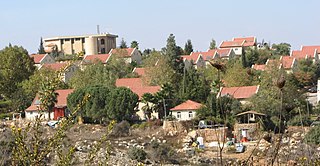
Ofra is an Israeli settlement located in the northern Israeli-occupied West Bank. Located on the main road between Jerusalem and Nablus, it falls under the jurisdiction of Mateh Binyamin Regional Council. In 2021 it had a population of 3,026.

Amona was an Israeli outpost in the central West Bank. Located on a hill overlooking Ofra within the municipal boundaries of the Mateh Binyamin Regional Council, the village was founded in 1995 on privately owned Palestinian land. As of 2012, its population was around 200. As of October 2013, the outpost lodged 42 families. It was evacuated completely in February 2017 in compliance with a ruling by the Israeli Supreme Court.

Kedumim, is an Israeli settlement organized as a local council located in the northern West Bank. Founded on Hanukkah 1975 by members of the Gush Emunim settlement movement, it later became a local council. In 2021 it had a population of 4,590.
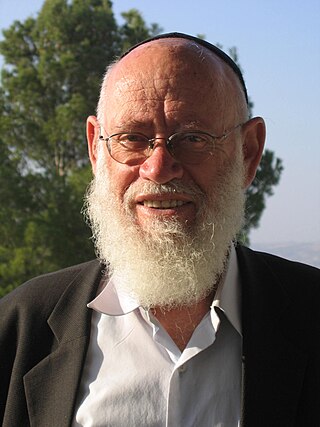
Moshe Levinger was an Israeli Religious Zionist activist and an Orthodox Rabbi who, since 1967, had been a leading figure in the movement to settle Jews in the territories occupied by Israel during the 1967 Six-Day War. He is especially known for leading Jewish settlement in Hebron in 1968, and for being one of the principals of the now defunct settler movement Gush Emunim, founded in 1974, among whose ranks he assumed legendary status. Levinger was reportedly involved in violent acts against Palestinians.
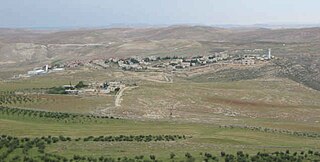
Nokdim is an Israeli settlement organized as a community settlement in the West Bank. Located south of Bethlehem in the northern Judean Mountains, it falls under the jurisdiction of Gush Etzion Regional Council. In 2021 it had a population of 2,764.
The Jewish Underground, or in abbreviated form, simply makhteret, was a radical right-wing fundamentalism organization considered terrorist by Israel, formed by prominent members of the Israeli political movement Gush Emunim that existed from 1979 to 1984. Two issues catalyzed the establishment of the underground: One was the signing of the Camp David Accords, which led to the Egypt–Israel peace treaty in 1979, and which the movement, opposed to the peace process, wished to block, viewing it as the first step in the establishment of a Palestinian state in the West Bank. A second element was the settlement project, which, in bringing two distinct ethnic communities into closer proximity, led to an uptick in hostilities that brought about a growing emphasis on the existential threat in both communities. The Jewish Underground developed two operational objectives: One consisted of a plot to blow up the Dome of the Rock, while the other branch concentrated on both avenging acts of Palestinian violence against settlers and of establishing a punitive deterrence. Some understood the terrorist acts as a means of inducing Palestinians to flee their homeland, based on the 1948 and 1967 experience, and parallels are drawn to the Terror Against Terror movement, which had a similar aim. Robert Friedman stated that the Makhteret was "the most violent anti-Arab terrorist organization since the birth of Israel".

Shavei Shomron is an Israeli settlement in the northern West Bank. Built on lands confiscated from the neighboring Palestinian villages of An-Naqura and Deir Sharaf, it is located to the west of Nablus, on the road to Tulkarm. It is organised as a community settlement and falls under the jurisdiction of Shomron Regional Council. In 2021 it had a population of 1,050, mostly religious Zionist and Modern Orthodox Jews. Its municipal jurisdiction is 664 dunams, of which 272 dunams are built up.

A community settlement is a type of town or village in Israel and in the West Bank. In an ordinary town, anyone may buy property, but in a community settlement, the village's residents are organized in a cooperative and have the power to approve or to veto a sale of a house or a business to any buyer. Residents of a community settlement may have a particular shared ideology, religious perspective or desired lifestyle, which they wish to perpetuate by accepting only like-minded individuals. For example, a family-oriented community settlement that wishes to avoid becoming a retirement community may choose to accept only young married couples as new residents.
Neo-Zionism is a right-wing, nationalistic and religious ideology that appeared in Israel following the Six-Day War in 1967 and the capture of the West Bank and Gaza Strip. Neo-Zionists consider these lands part of Israel and advocate their settlement by Israeli Jews. Some advocate the transfer of Arabs not only from these areas but also from within the Green Line.

Giv'on HaHadashah is an Israel settlement in the West Bank, built over land expropriated from the neighboring Palestinian villages of Biddu, Beit Ijza, and Al Jib. It falls under the jurisdiction of Mateh Binyamin Regional Council. In 2021 it had a population of 1,020.

Beit Hagai, also Hagai, is an Israeli settlement organized as a community settlement located in the southern Hebron hills in the West Bank. The settlement population was 460 in 2004, according to a classified government document published by the Haaretz newspaper, and lies within the municipal jurisdiction of the Har Hevron Regional Council. The religious Jewish community's name, Haggai, is an acronym of the given names Hanan Krauthammer, Gershon Klein, and Yaakov Zimmerman, three Nir Yeshiva students murdered in the 1980 Hebron terrorist attack. The community rabbi for Beit Hagai is Rabbi Moshe Eliezer Rabinovich (HaLevy). In 2021 it had a population of 701. The international community considers Israeli settlements in the West Bank illegal under international law, but the Israeli government disputes this.
Hanan Porat was an Israeli Orthodox rabbi, educator, and politician who served as a member of the Knesset for Tehiya, the National Religious Party, Tkuma, and the National Union between 1981 and 1984, and between 1988 and 1999.
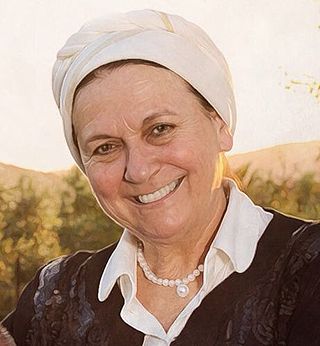
Daniella Weiss is a far-right Israeli Orthodox Zionist settlement movement extremist, and a former mayor of Kedumim, an Israeli settlement located in the West Bank. She was first elected mayor of Kedumim in September 1996, and was re-elected for a second term in November 2001 through 2007.
References
- ↑ Goldberg, Giora (1993). Ben-Zadok, Efraim (ed.). Gush Emunim New Settlements in the West Bank: From Social Movement to Regional Interest Group. SUNY series in Israeli studies. SUNY Press. p. 199. ISBN 9780791415610 . Retrieved 18 November 2011.
{{cite book}}:|work=ignored (help) - ↑ Myron J. Aronoff (1989). Israeli Visions and Divisions . Transaction Publishers. p. 83. ISBN 9780887382550 . Retrieved November 18, 2011.
amana settlement movement.
- 1 2 "אמנה - תנועת ההתיישבות - about us". Amana.co.il. Archived from the original on October 22, 2011. Retrieved November 18, 2011.
- ↑ "The Geneva Convention". BBC News. 10 December 2009. Retrieved 27 November 2010.
- ↑ Yishai, Yael (1987). Land or peace: whither Israel?. Hoover Press publication, Volume 352. Hoover Press. p. 120. ISBN 9780817985233 . Retrieved 18 November 2011.
- ↑ Kass, Ilana; O'Neill, Bard E. (1997). The deadly embrace: the impact of Israeli and Palestinian rejectionism on the peace process. University Press of America. ISBN 9780761805359 . Retrieved 18 November 2011.
- ↑ Kellerman, Aharon (1993). Society and settlement: Jewish land of Israel in the twentieth century . SUNY Press. p. 93 . Retrieved 18 November 2011.
amana settlement movement
- ↑ Gideon, Aran (1994). Marty, Martin E.; Appleby, R. Scott (eds.). Jewish Zionist Fundamentalism: The Bloc of the Faithful in Israel (Gush Emunim). The Fundamentalism Project. Vol. 1. University of Chicago Press for the American Academy of Arts and Sciences. p. 282. ISBN 9780226508788 . Retrieved November 18, 2011.
{{cite book}}:|work=ignored (help) - 1 2 3 Levinson, Chaim (1 February 2016). "Almost All West Bank Land Deals for Illegal Settlements Forged, Investigation Finds". Haaretz.